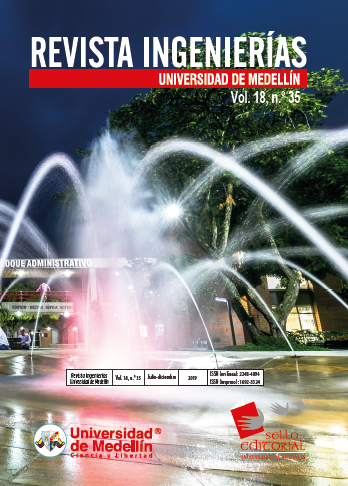Degradation of Ethylene Glycol Through Photo-Fenton Heterogeneous System
DOI:
https://doi.org/10.22395/rium.v18n35a6Keywords:
ethylene glycol, photo-Fenton system, heterogeneous photodegradation, Fe-doped TiO2, sol-gel method, incipient wet impregnationAbstract
This work describes the ethylene glycol degradation in a photo-Fenton heterogeneous system. Iron-doped TiO2 photocatalysts prepared by different methods (incipient wet impregnation and sol-gel method), as well as the corresponding un-doped material were examined in this process. Different values of initial pH and H2O2 concentration were tested during the experiments. A lower photoactivity was observed for the un-doped materials than for the Fe-doped materials. Optimum results of initial pH and H2O2 concentrations were found to be 3.0 and 1,000 mg/L, respectively. Furthermore, the highest degradation percentage of ethylene glycol (61 %) was achieved for the material synthetized by sol-gel method. Such catalytic performance is explained on the basis of structural/morphological and electronic characterization results, reached by XRD, UV-vis DRS and XPS techniques. To the best of our knowledge, this is the first report related with the ethylene glycol degradation using Iron-doped TiO2 in a photo-Fenton heterogeneous system.
Downloads
References
[1] A. N. Ardila Arias, E. Arriola Villaseñor, J. Reyes Calle, E. Berrio Mesa, and G. Fuentes Zurita, “Mineralización de etilenglicol por foto-Fenton asistido con ferrioxalato,†Rev. Int. Contam. Ambient., vol. 32, n.º 2, pp. 213-226, 2016. DOI: http://dx.doi.org/10.20937/RICA.2016.32.02.07
[2] B. D. McGinnis, V. D. Adams, and E. J. Middlebrooks, “Degradation of ethylene glycol in photo Fenton systems,†Water Res., vol. 34, n.º 8, pp. 2346-2354, 2000. DOI: http://dx.doi.org/10.1016/S0043-1354(99)00387-5
[3] B. Dietrick McGinnis, V. Dean Adams, and E. Joe Middlebrooks, “Degradation of ethylene glycol using Fenton’s reagent and UV,†Chemosphere, vol. 45, n.º 1, pp. 101-108, 2001. DOI: http://dx.doi.org/10.1016/S0045-6535(00)00597-X
[4] J. Araña, J. A. Ortega Méndez, J. A. Herrera Melián, J. M. Doña RodrÃguez, O. González DÃaz, and J. Pérez Peña, “Thermal effect of carboxylic acids in the degradation by photo-Fenton of high concentrations of ethylene glycol,†Appl. Catal. B Environ., vol. 113-114, pp. 107-115, 2012. DOI: http://dx.doi.org/10.1016/j.apcatb.2011.11.025
[5] C. E. DÃaz-Uribe, W. A. Vallejo L., and J. Miranda, “Photo-Fenton oxidation of phenol with Fe(III)-tetra-4- carboxyphenylporphyrin/SiO2 assisted with visible light,†J. Photochem. Photobiol. A Chem., vol. 294, pp. 75-80, 2014. DOI: http://dx.doi.org/10.1016/j.jphotochem.2014.08.004
[6] T. Tachikawa et al., “Visible Light-Induced Degradation of Ethylene Glycol on Nitrogen-Doped TiO2 Powders,†J. Phys. Chem. B, vol. 110, n.º 26, pp. 13158-13165, 2006. DOI: http://dx.doi.org/10.1021/jp0620217
[7] T. Aguilar et al., “A route for the synthesis of Cu-doped TiO2 nanoparticles with a very low band gap,†Chem. Phys. Lett., vol. 571, pp. 49-53, 2013. DOI: http://dx.doi.org/10.1016/j.cplett.2013.04.007
[8] D. V. Wellia, Q. C. Xu, M. A. Sk, K. H. Lim, T. M. Lim, and T. T. Y. Tan, “Experimental and theoretical studies of Fe-doped TiO2 films prepared by peroxo sol-gel method,†Appl. Catal. A Gen., vol. 401, n.º 1-2, pp. 98-105, 2011. DOI: http://dx.doi.org/10.1016/j.apcata.2011.05.003
[9] A. Lassoued, B. Dkhil, A. Gadri, and S. Ammar, “Control of the shape and size of iron oxide (α-Fe2O3) nanoparticles synthesized through the chemical precipitation method,†Results Phys., vol. 7, pp. 3007-3015, 2017. DOI: http://dx.doi.org/10.1016/j.rinp.2017.07.066
[10] Y. Liu et al., “Enhanced visible light photocatalytic properties of Fe-doped TiO2 nanorod clusters and monodispersed nanoparticles,†Appl. Surf. Sci., vol. 257, n.º 18, pp. 8121-8126, 2011. DOI: http://dx.doi.org/10.1016/j.apsusc.2011.04.121
[11] C. Yu, Q. Fan, Y. Xie, J. Chen, Q. shu, and J. C. Yu, “Sonochemical fabrication of novel square-shaped F doped TiO2 nanocrystals with enhanced performance in photocatalytic degradation of phenol,†J. Hazard. Mater., vol. 237-238, pp. 38-45, 2012. DOI: http://dx.doi.org/10.1016/j.jhazmat.2012.07.072
[12] A. Montesinos-Castellanos and T. A. Zepeda, “High hydrogenation performance of the mesoporous NiMo/Al(Ti, Zr)-HMS catalysts,†Microporous Mesoporous Mater., vol. 113, n.º 1-3, pp. 146-162, 2008. DOI: http://dx.doi.org/10.1016/j.micromeso.2007.11.012
[13] P. Reyes, H. Rojas, and J. L. G. Fierro, “Kinetic study of liquid-phase hydrogenation of citral over Ir/TiO2 catalysts,†Appl. Catal. A Gen., vol. 248, no. 1-2, pp. 59-65, 2003. DOI: http://dx.doi.org/10.1016/S0926-860X(03)00148-0
[14] C. Adán, A. Bahamonde, I. Oller, S. Malato, and A. MartÃnez-Arias, “Influence of iron leaching and oxidizing agent employed on solar photodegradation of phenol over nanostructured iron-doped titania catalysts,†Appl. Catal. B Environ., vol. 144, n.º 1, pp. 269-276, 2014. DOI: http://dx.doi.org/10.1016/j.apcatb.2013.07.027
[15] S. H. Lin, C. H. Chiou, C. K. Chang, and R. S. Juang, “Photocatalytic degradation of phenol on different phases of TiO2 particles in aqueous suspensions under UV irradiation,†J. Environ. Manage., vol. 92, n.º 12, pp. 3098-3104, 2011. DOI: http://dx.doi.org/10.1016/j.jenvman.2011.07.024
[16] H. B. Hadjltaief, M. Ben Zina, M. E. Galvez, and P. Da Costa, “Photo-Fenton oxidation of phenol over a Cu-doped Fe-pillared clay,†Comptes Rendus Chim., vol. 18, n.º 10, pp. 1161-1169, 2015. DOI: http://dx.doi.org/10.1016/j.crci.2015.08.004
[17] E. Martin Del Campo, R. Romero, G. Roa, E. Peralta-Reyes, J. Espino-Valencia, and R. Natividad, “Photo-Fenton oxidation of phenolic compounds catalyzed by iron-PILC,†Fuel, vol. 138, pp. 149-155, 2014. DOI: http://dx.doi.org/10.1016/j.fuel.2014.06.014
[18] Z. Shiyun, Z. Xuesong, L. Daotang, and C. Weimin, “Ozonation of naphthalene sulfonic acids in aqueous solutions: Part II - Relationships of their COD, TOC removal and the frontier orbital energies,†Water Res., vol. 37, n.º 5, pp. 1185-1191, 2003. DOI: http://dx.doi.org/10.1016/S0043-1354(02)00178-1
[19] Z. Shiyun, Z. Xuesong and L. Daotang, “Ozonation of naphthalene sulfonic acids in aqueous solutions: Part I- Relationships of their COD, TOC removal and the frontier orbital energies,†Water Res., vol. 37, n.º 5, pp. 1237-1243, 2002. DOI: http://dx.doi.org/10.1016/S0043-1354(01)00331-1
[20] L. Türker, T. Atalar, S. Gümüş, and Y. Çamur, “A DFT study on nitrotriazines,†J. Hazard. Mater., vol. 167, n.º 1-3, pp. 440-448, 2009. DOI: http://dx.doi.org/10.1016/j.jhazmat.2008.12.134
Downloads
Published
How to Cite
Issue
Section
License
The total or partial reproduction of the contents of the journal for educational, research, or academic purposes is authorized as long as the source is cited. For reproduction for other purposes, express authorization from the Sello Editorial Universidad de MedellÃn is required.

